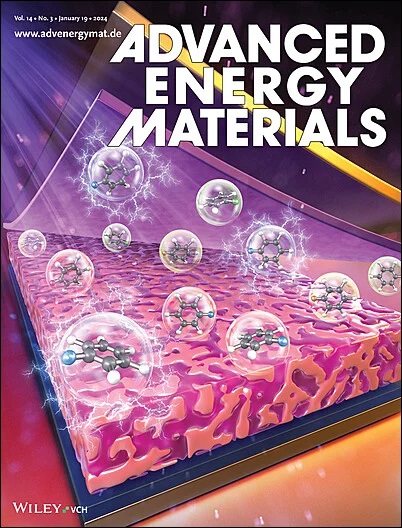Operationally Stable Perovskite/Silicon Tandem Solar Cells via Suppression of Lead Iodide‐Mediated Phase Segregation in Wide‐Bandgap Perovskites
IF 24.4
1区 材料科学
Q1 CHEMISTRY, PHYSICAL
引用次数: 0
Abstract
Phase segregation in wide‐bandgap mixed‐halide perovskites remains a critical bottleneck for the operational stability of solar cells, including tandem architectures. While lead iodide (PbI通过抑制宽禁带钙钛矿中碘化铅介导的相偏析,实现运行稳定的钙钛矿/硅串联太阳能电池
宽禁带混合卤化物钙钛矿中的相偏析仍然是太阳能电池(包括串联结构)运行稳定性的关键瓶颈。虽然结晶过程中晶界的碘化铅(PbI2)偏析现在被认为是这种降解的关键驱动因素,但在源头抑制其形成的策略仍未得到充分探索。在这里,这个挑战是通过原位交联添加剂工程来调节钙钛矿结晶来解决的。交联聚合物网络的形成固定了Pb相关框架,促进了PbI2抑制下更完整的钙钛矿相变。这些网络均匀分布在钙钛矿晶界中,同时钝化缺陷和抑制离子迁移,从而导致钙钛矿中的相偏析。该方法使1.68 eV钙钛矿太阳能电池的功率转换效率达到23.03%,并增强了运行稳定性,在最大功率点跟踪下,在1100小时后保持了90%以上的初始性能。集成的钙钛矿/硅串联电池在1平方厘米的面积内提供了32.57%(32.41%)的认证效率,在45°C的高温下进行1400小时的照明测试后保持率为90%。
本文章由计算机程序翻译,如有差异,请以英文原文为准。
求助全文
约1分钟内获得全文
求助全文
来源期刊

Advanced Energy Materials
CHEMISTRY, PHYSICAL-ENERGY & FUELS
CiteScore
41.90
自引率
4.00%
发文量
889
审稿时长
1.4 months
期刊介绍:
Established in 2011, Advanced Energy Materials is an international, interdisciplinary, English-language journal that focuses on materials used in energy harvesting, conversion, and storage. It is regarded as a top-quality journal alongside Advanced Materials, Advanced Functional Materials, and Small.
With a 2022 Impact Factor of 27.8, Advanced Energy Materials is considered a prime source for the best energy-related research. The journal covers a wide range of topics in energy-related research, including organic and inorganic photovoltaics, batteries and supercapacitors, fuel cells, hydrogen generation and storage, thermoelectrics, water splitting and photocatalysis, solar fuels and thermosolar power, magnetocalorics, and piezoelectronics.
The readership of Advanced Energy Materials includes materials scientists, chemists, physicists, and engineers in both academia and industry. The journal is indexed in various databases and collections, such as Advanced Technologies & Aerospace Database, FIZ Karlsruhe, INSPEC (IET), Science Citation Index Expanded, Technology Collection, and Web of Science, among others.
 求助内容:
求助内容: 应助结果提醒方式:
应助结果提醒方式:


